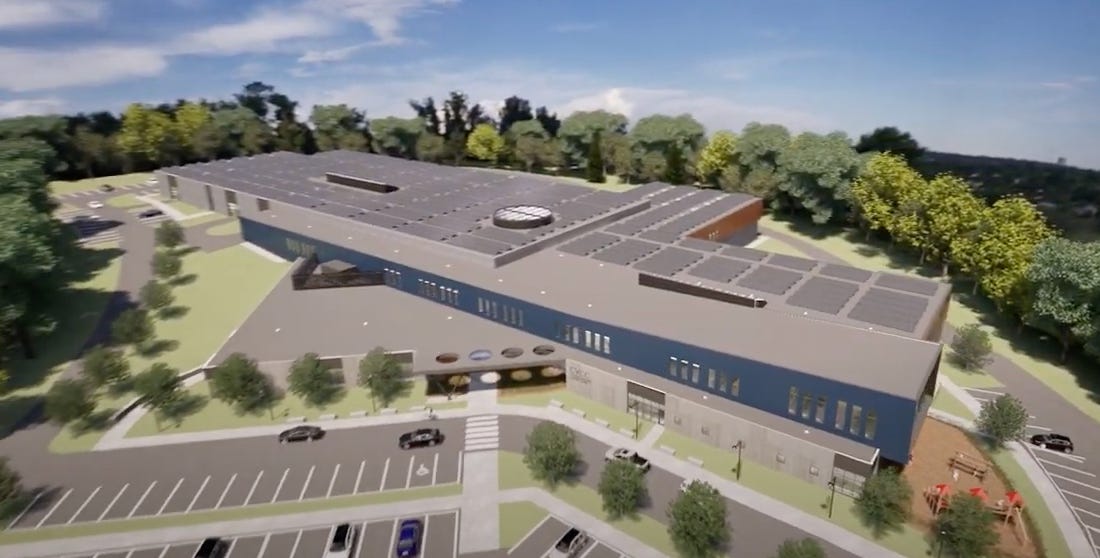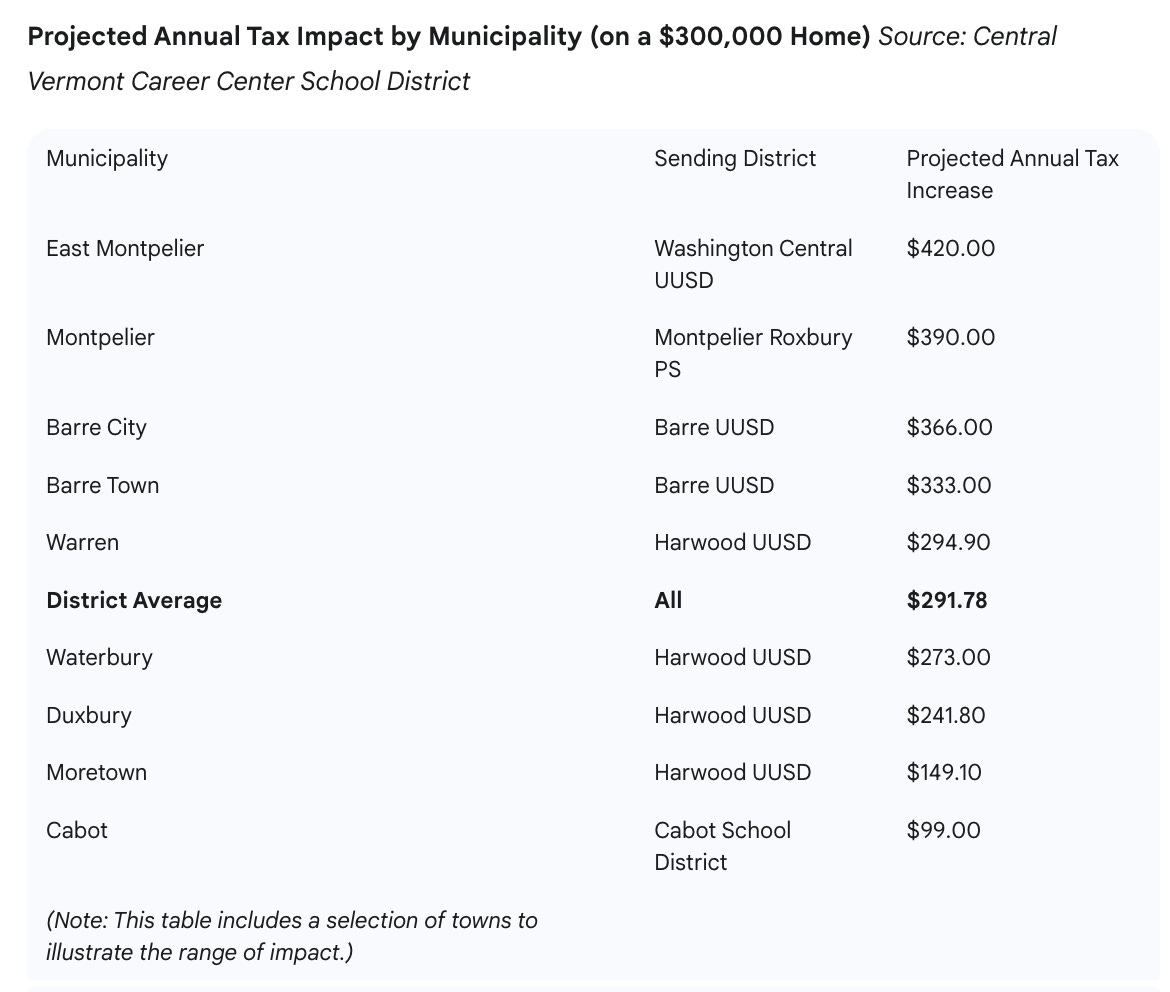Four Unexplored Points Voters Need Before the $149M Central VT Career Center Bond Vote
Voters are being asked to approve the bond without a complete picture. Here are four crucial points that have not been fully addressed in the public discourse.
On November 4, voters across 18 Central Vermont municipalities will determine the fate of a $149 million bond to build a new Central Vermont Career Center (CVCC) campus. According to CVCC leadership, the proposal is a “once-in-a-lifetime investment” to address a critical need. The current 44,000-square-foot wing at Spaulding High School, in use since 1969, is described as outdated and too small, forcing the center to turn away more than 150 qualified applicants each year.
The $149 million bond would finance a new 167,000-square-foot campus on 27 acres in Graniteville. This would more than double student capacity from approximately 220 to 500, shift from a half-day to a comprehensive full-day program, and add new curricula in high-demand fields like cybersecurity and diesel mechanics. Proponents argue this is essential to meet overwhelming student demand and align training with the region’s workforce needs.
This investment, however, comes at a time of significant financial pressure. Citing recent flood recovery, rising property taxes, and statewide school redistricting uncertainty, opponents have called the proposal “tone-deaf” and its design extravagant.
The core of the financial debate lies in a recent change in state policy. The Vermont State Legislature has suspended the School Construction Aid Program. As the official bond warning explicitly states, this means “100% of the project shall be built at the school district’s cost without State participation.” The entire 30-year debt will be borne by local taxpayers, making Central Vermont a test case for funding major school projects in this new fiscal reality.
The Taxpayer Impact: A Tale of 18 Towns
The CVCC district does not levy taxes directly. Instead, it is funded by tuition payments from the six sending school districts it serves. The annual debt service for the bond, estimated at $9.4 million, would be incorporated into these tuition costs.
Those costs are allocated based on a “six-semester average” of student enrollment, not on a town’s property value or population. This creates significant disparities in the projected tax burden across the 18 member towns.
CVCC officials have provided “good faith estimates” for the annual property tax increase on a home valued at $300,000. While the district-wide average is projected to be $291.78, the impact ranges from $99 in Cabot to $420 in East Montpelier—a more than four-fold difference for the same regional facility.
The Four Unexplored Issues
While the public debate has focused on the sticker price versus student demand, a review of public statements and reporting reveals critical information gaps. Voters are being asked to approve the bond without a complete picture. Here are four crucial points that have not been fully addressed in the public discourse.
1. What are the long-term operating costs?
The $149 million bond covers design and construction. It does not account for the annual costs of operating the new facility. The proposed 167,000-square-foot campus is nearly four times the size of the current space. This will inevitably lead to substantially higher annual expenses for heating, electricity, custodial services, maintenance, and potentially new administrative and support staff.
These recurring operational costs will be added to CVCC’s annual budget and passed on to taxpayers through the same tuition mechanism, just like the bond payments, for the life of the building. To date, no public projections of this long-term financial impact have been provided. Voters only know the cost to build the facility, not the long-term cost to run it.
2. Why not renovate? A missing alternatives analysis.
Many residents have publicly questioned why the existing wing at Spaulding High School cannot be renovated and expanded. At one forum, according to reporting, Barre Town resident Sue Paxman noted that Spaulding was built for over 1,200 students and now enrolls less than half that, suggesting space should be available.
Project officials have stated that an expansion at the current site was considered but ultimately deemed unsuitable due to a lack of space for new programs and the logistical challenges of construction. However, a detailed feasibility study or a comparative cost-benefit analysis that led to this conclusion has not been made widely public. Voters have been presented with the district’s conclusion—that a new build is the only viable option—without access to the detailed analysis weighing the $149 million new facility against other potentially more economical options.
3. Where is the specific, regional labor data?
A core argument for the new facility is the need to align education with the demands of the local workforce. Proponents are guided by a needs assessment to ensure offerings match “high-skill, high-pay, high-demand jobs.”
While statewide data, such as that from the McClure Foundation, points to a general need for skilled trades, the public-facing case has lacked specific, granular labor market data for the Central Vermont region (primarily Washington, Orange, and Lamoille counties). There has been no detailed public data presented to validate the local demand for each of the proposed new programs, such as cybersecurity or diesel mechanics. This leaves a gap between the general argument about workforce needs and the specific, costly programmatic investments being proposed.
4. Why is the regional business community silent?
The entire project is framed as a primary solution to the region’s persistent workforce shortages, a constant refrain from local employers. Given this, the public stance of the business community is a critical piece of the story.
However, public reporting shows no evidence of formal endorsements from major regional business organizations, such as the Central Vermont Chamber of Commerce or the Central Vermont Economic Development Corporation. While these groups are broadly focused on workforce development, their apparent public silence on what would be the single largest workforce project in the region’s history is a notable omission. The support, or lack thereof, from these groups would provide a powerful signal to voters about the project’s perceived economic value.
The Voter’s Dilemma
The decision facing Central Vermont voters is a complex trade-off with 30-year consequences. The need to expand technical education is clear and supported by a multi-year waiting list of students. The vision for a modern, full-day program is compelling.
Voters must weigh this vision against the substantial and entirely local financial commitment. They must decide if the potential long-term economic benefit of a better-trained workforce outweighs the immediate and sustained tax burden, especially at a time of economic uncertainty. And crucially, they must decide if they have been given enough information to approve a $149 million project while key questions about long-term costs, alternatives, and economic validation remain unanswered.




